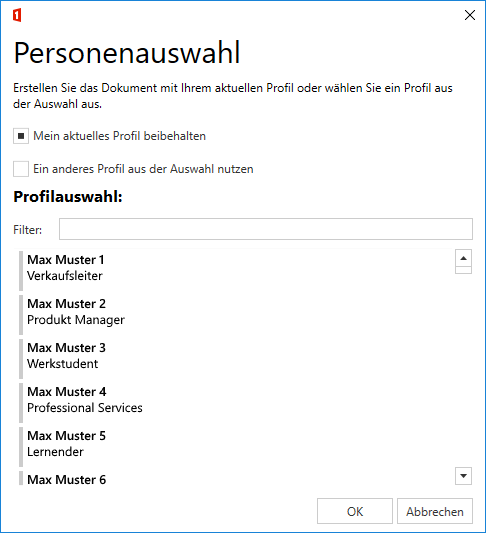PeoplePicker
When adding the PeoplePicker, a dialog appears when creating a document, through which another person can be selected as a profile:

Important
Currently, the only source supported is the AD (Active Directory). Authentication is done via the current Windows user.
Restrictions
When using the PeoplePicker, the following points must be observed:
- The PeoplePicker works outside the existing sharing concept of OneOffixx profiles. Only AD users can be selected and no OneOffixx profiles can be selected for which one is authorized.
- There is no possibility to access the data of OneOffixx users or OneOffixx profiles. For example, if the signature images are maintained in the OneOffixx users, this data cannot be accessed with the PeoplePicker.
- Only those fields that are explicitly specified will be overwritten. If the fields "Profile.Id", "Profile.User.FirstName" and "Signer_0.User.Sign" are not specified in FieldMapping, they will contain the data of the current profile (and not the data of the person selected in the PeoplePicker).
- The possibility to select a person in the PeoplePicker is available only when creating the document. In generated documents, the PeoplePicker cannot be called again.
Profile changes work, but have the effect of overwriting the data that was filled by the PeoplePicker. - During person selection, the information of the profile used is overwritten. If not all profile data is available for the profile selected in the PeoplePicker, those of the current profile will be used.
Basically, it is strongly recommended to use the OneOffixx function "Profile releases".
Configuration
Here is an example configuration:
<Config>
<Provider>
<Ldap>
<PropertiesToLoad>sn,givenName,description,department,mail</PropertiesToLoad>
</Ldap>
</Provider>
<FieldMapping>
<MapFieldNames>*</MapFieldNames>
<Element id="departmentEdited" when="department = 'Sales'">"Sales"</Element>
<Element id="departmentEdited" notwhen="department = 'Sales'">department</Element>
<Element id="mailLowerCase" fCase="lower">mail</Element>
<Element id="emptyImage">""</Element>
</FieldMapping>
<FieldsToProfileMapping>
<Map source="sn" target="Profile.User.LastName" />
<Map source="givenName" target="Profile.User.Firstname" />
<Map source="description" target="Profile.User.Function" />
<Map source="departmentEdited" target="Profile.Org.Unit" />
<Map source="mailLowerCase" target="Profile.User.Email" />
<Map source="emptyImage" target="Profile.User.Sign" />
<Map source="emptyImage" target="Signer_0.User.Sign" />
</FieldsToProfileMapping>
</Config>
Between <PropertiesToLoad> and </PropertiesToLoad> the AD user attributes can be specified, which can be requested by the AD and subsequently used in the mapping.
In <FieldMapping> additional elements can be created, which can then be used in <FieldsToProfileMapping>. In doing so, the same attributes can be used in <Element ... /> the same attributes can be used as in the document function Scripts.
In <FieldsToProfileMapping> all fields to be overwritten by AD data must be specified.
Alternative
This function only works with LDAP systems and requires further input from the user. In principle, profile data can also be controlled via Connect, see the Connect function ProfileData.